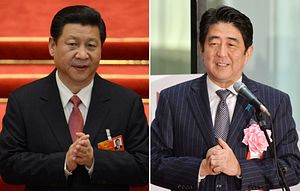From a surface view, it appears that strained relations between Tokyo and Beijing are experiencing a slight détente. Japan’s Prime Minister Shinzo Abe held two summit meetings with his Chinese counterparts—one with Chinese President Xi Jinping last April in Jakarta and the second with Premier Li Keqiang on the sidelines of the Trilateral Summit with South Korea this past November in Seoul. There also has been increased dialogue between foreign ministers, resuscitated talks on security and maritime affairs, and high-level commitments to implement crisis avoidance mechanisms to avert a potential clash over their dispute in the East China Sea.
There were other positive signs too. Abe appears more willing to accommodate Chinese concerns about Japan’s approach toward history through his decision not to visit the controversial Yasukuni shrine (after his provocative visit in December 2013 enraged Beijing). And, while it received boiler-plate criticism from Beijing, Abe’s statement on the 70th anniversary of the end of World War II last August made reference to upholding previous statements—including the Murayama Statement—on Japan’s wartime contrition and guilt.
China, too, has responded with a more pragmatic approach to its relations with Japan. Beijing finally abandoned its stubborn and ineffective approach of pre-conditioning high-level dialogue upon Japan’s willingness to make concessions over the disputed Senkaku (referred to as Diayou in China) Islands. Meanwhile, despite constant public statements of concern, Beijing has ratcheted down the overt rhetoric of its criticisms of Japan’s attitude toward history.
On the economic front, trade continues to be the linchpin of the relationship—China remains Japan’s largest trading partner by far; likewise, despite adverse impacts from their political rift, China also relies on trade with Japan (which is its second most important partner after the United States). According to Japan’s External Trade Organization, trade between the two countries amassed over $343.7 billion in 2014. Another positive is the momentum on a potentially historic trilateral free trade agreement (FTA), currently under advanced negotiation, alongside South Korea. The China-Japan-Korea FTA would combine three of the largest economies in the Asia-Pacific and represent a convergence of more than $16.5 trillion, as measured through gross domestic product.
However, this “glass half-full perspective” should not blind observers to the real troubles that remain in the bilateral relationship—most of which are systemic and bound up in the countries’ competing strategic interests in East Asia. Indeed, despite their economic interconnectedness, Tokyo and Beijing appear to be diverging more than converging. Last year, Japan refrained from joining the Chinese-led Asian Infrastructure Investment Bank (AIIB)—being the only country in East Asia besides North Korea that has opted out. Meanwhile, Tokyo remains wary of China’s ambitious plans to increase connectivity and infrastructure through its “One Belt, One Road” strategy, which prescribes massive development in Central and South Asia.
Aside from these differences, trade between Japan and China has also suffered. According to JETRO, bilateral trade decreased 12.1 percent over the first half of 2015. The most precipitous decline was on Japanese imports of Chinese products, which plummeted more than 13 percent during this same period. These trends are unlikely to subside. Indeed, some of the most impacted areas—such as trade in textiles—are likely to decline even more in the coming years as Japanese companies have relocated many of their manufacturing bases to Southeast Asian nations such as Vietnam or Indonesia.
This economic decline is magnified by strained political relations that—despite the resumption of high-level dialogue—remain at their nadir. Beijing continues to play hardball with Japan over their dispute in the East China Sea and has upped the ante recently with the introduction of armed coast guard vessels traversing the territorial waters surrounding the Senkaku/Diayou islands. Meanwhile, the number of incursions by Chinese vessels over the past year has actually increased—despite Abe and Xi breaking the ice and sitting down twice to ostensibly improve bilateral relations. But perhaps most unnerving is the fact that Tokyo and Beijing have failed to implement even the baseline crisis avoidance tools in the disputed waters—such as a hotline or common radio frequency.
Political ties will likely suffer even more due to Japan’s improvement in relations with China’s neighbors. Abe has invested an unprecedented amount of travel time and political capital through international visits. Japan is also reaching new heights with its traditionally good relationships with Australia, India, and even Taiwan. Even ties with South Korea, which had been on ice since Abe was elected in late 2012, are improving now under the momentum of last month’s deal on “comfort women” (sex slaves). Japan’s diplomatic surge in the region further isolates assertive Chinese behavior in the maritime domain—including the East and South China Seas—and solidifies its image in China as a growing strategic competitor.
The coming months provide opportunity for Japan and China to adopt a pragmatic approach to their ties. Both sides should push through on crisis mitigation measures in the East China Sea before an unintended incident pits them in an intractable situation. Similarly, they can restore political trust through strong reengagement in the trilateral context with South Korea, with the priority being a swift conclusion of the CJK FTA. Whether the political leadership on both sides can overcome the pressures on the relationship will be the key determinant on whether pragmatism wins over antagonism.
This article has previously been published on the EastWest Institute Policy Innovation Blog.

































